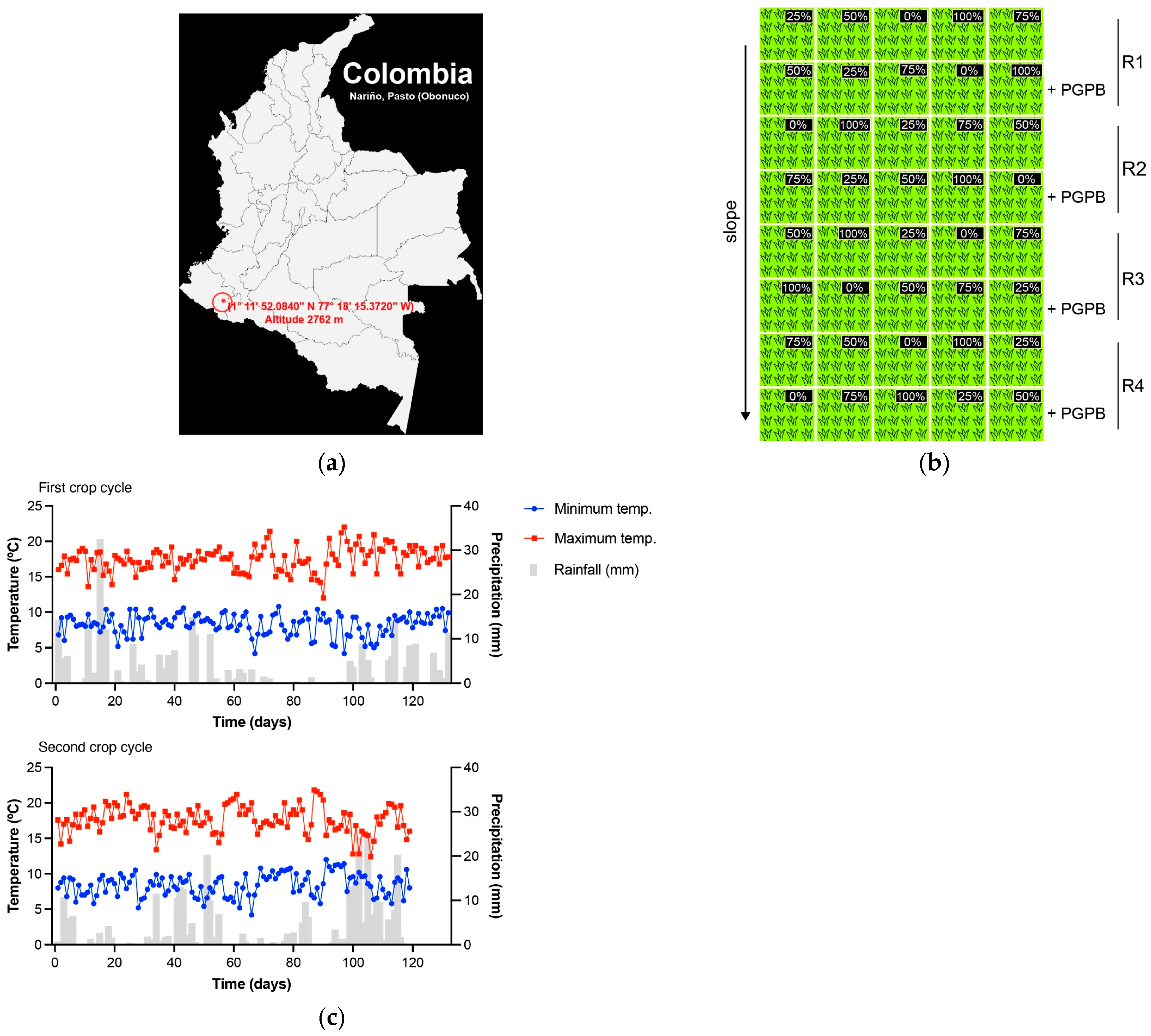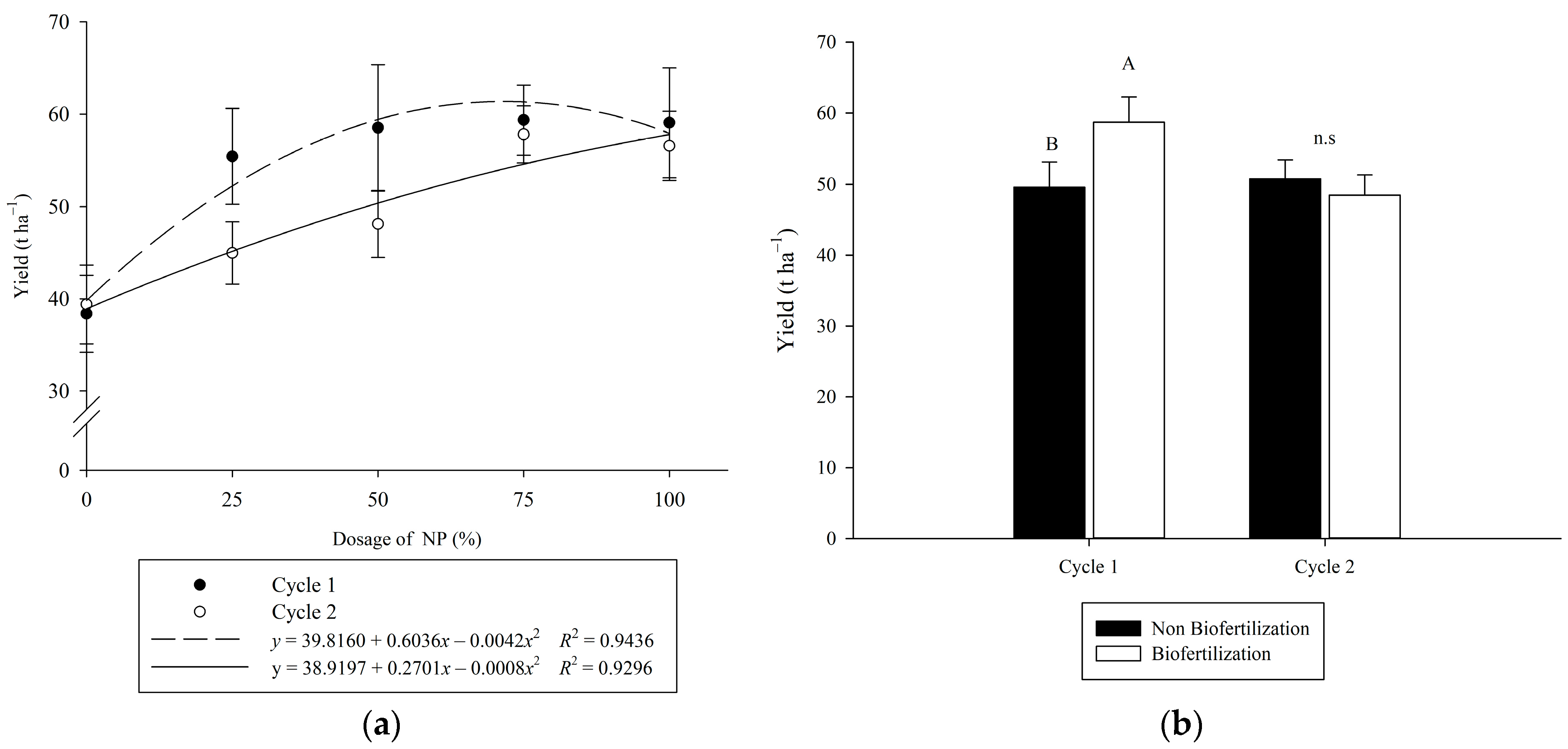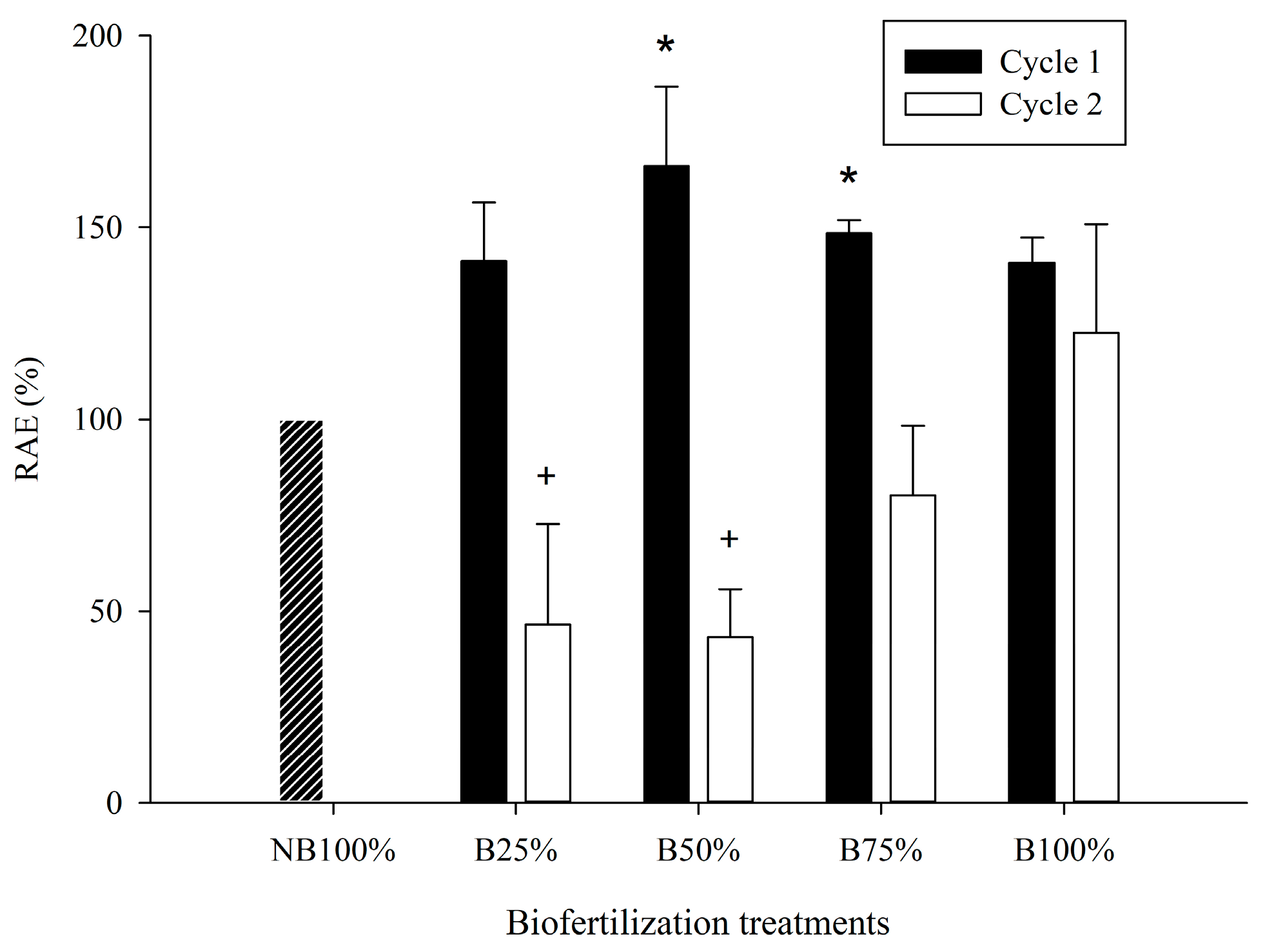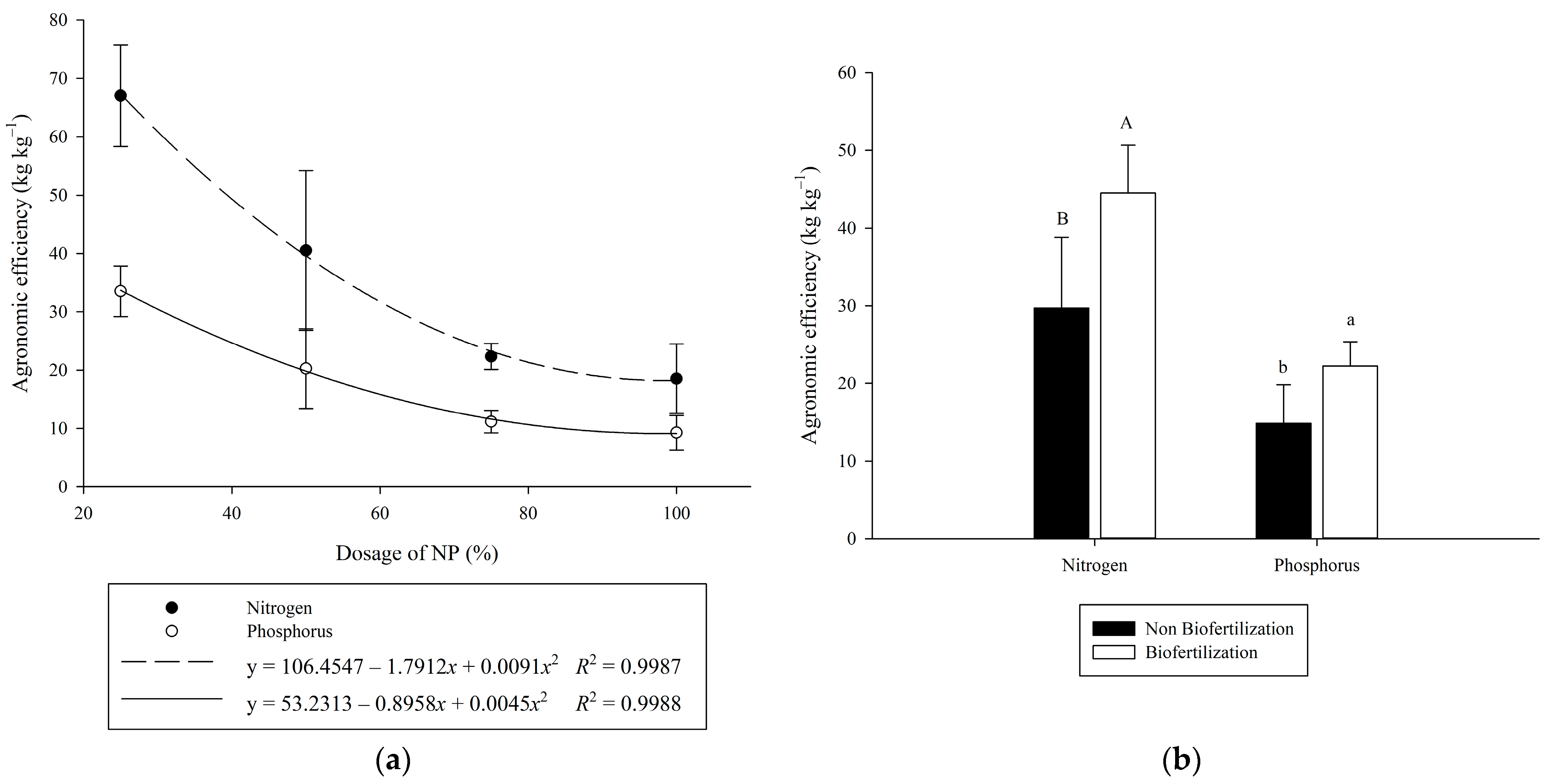Effect of Mineral Fertilization and Microbial Inoculation on Cabbage Yield and Nutrition: A Field Experiment
Abstract
1. Introduction
2. Materials and Methods
2.1. Experimental Design and Field Experiment Conditions
2.2. Microbial Strains and Inoculum Culture Conditions
2.3. N and P Fertilization
2.4. Evaluation of Cabbage Growth and Yield
2.5. Statistical Analysis
3. Results
3.1. Impact of Mineral and Biological Fertilization on N and P Uptake
3.2. Impact of Mineral and Biological Fertilization on Cabbage Yield
3.3. Effect of Mineral and Biological Fertilization on Cabbage Head Weight
3.4. Relative Effect of Biological Fertilization on Agronomic Efficiency
3.5. Agronomic Efficiency of Nitrogen and Phosphorus
4. Discussion
5. Conclusions
Author Contributions
Funding
Data Availability Statement
Acknowledgments
Conflicts of Interest
References
- Moreb, N.; Murphy, A.; Jaiswal, S.; Jaiswal, A.K. Cabbage. In Nutritional Composition and Antioxidant Properties of Fruits and Vegetables; Elsevier: Amsterdam, The Netherlands, 2020; pp. 33–54. [Google Scholar]
- MADR. Cadena de Las Hortalizas; Ministerio de Agricultura y Desarrollo Rural: Bogotá, Colombia, 2021. Available online: https://sioc.minagricultura.gov.co/Hortalizas/Documentos/2019-06-30%20Cifras%20Sectoriales.pdf (accessed on 18 December 2023).
- Jin, L.; Jin, N.; Wang, S.; Li, J.; Meng, X.; Xie, Y.; Wu, Y.; Luo, S.; Lyu, J.; Yu, J. Changes in the Microbial Structure of the Root Soil and the Yield of Chinese Baby Cabbage by Chemical Fertilizer Reduction with Bio-Organic Fertilizer Application. Microbiol. Spectr. 2022, 10, e01215-22. [Google Scholar] [CrossRef] [PubMed]
- Kanter, D.R.; Chodos, O.; Nordland, O.; Rutigliano, M.; Winiwarter, W. Gaps and Opportunities in Nitrogen Pollution Policies around the World. Nat. Sustain. 2020, 3, 956–963. [Google Scholar] [CrossRef]
- Poria, V.; Dębiec-Andrzejewska, K.; Fiodor, A.; Lyzohub, M.; Ajijah, N.; Singh, S.; Pranaw, K. Plant Growth-Promoting Bacteria (PGPB) Integrated Phytotechnology: A Sustainable Approach for Remediation of Marginal Lands. Front. Plant. Sci. 2022, 13, 999866. [Google Scholar] [PubMed]
- Emmanuel, O.C.; Babalola, O.O. Productivity and Quality of Horticultural Crops through Co-Inoculation of Arbuscular Mycorrhizal Fungi and Plant Growth Promoting Bacteria. Microbiol. Res. 2020, 239, 126569. [Google Scholar] [CrossRef] [PubMed]
- Demay, J.; Ringeval, B.; Pellerin, S.; Nesme, T. Half of Global Agricultural Soil Phosphorus Fertility Derived from Anthropogenic Sources. Nat. Geosci. 2023, 16, 69–74. [Google Scholar]
- Raymond, J.; Siefert, J.L.; Staples, C.R.; Blankenship, R.E. The Natural History of Nitrogen Fixation. Mol. Biol. Evol. 2004, 21, 541–554. [Google Scholar] [CrossRef] [PubMed]
- Cassán, F.; Coniglio, A.; López, G.; Molina, R.; Nievas, S.; de Carlan, C.L.N.; Donadio, F.; Torres, D.; Rosas, S.; Pedrosa, F.O.; et al. Everything You Must Know about Azospirillum and Its Impact on Agriculture and Beyond. Biol. Fertil. Soils 2020, 56, 461–479. [Google Scholar] [CrossRef]
- Beltran-Medina, I.; Romero-Perdomo, F.; Molano-Chavez, L.; Gutiérrez, A.Y.; Silva, A.M.M.; Estrada-Bonilla, G. Inoculation of Phosphate-Solubilizing Bacteria Improves Soil Phosphorus Mobilization and Maize Productivity. Nutr. Cycl. Agroecosyst. 2023, 126, 21–34. [Google Scholar] [CrossRef]
- Sarkar, D.; Sankar, A.; Devika, O.S.; Singh, S.; Shikha; Parihar, M.; Rakshit, A.; Sayyed, R.Z.; Gafur, A.; Ansari, M.J.; et al. Optimizing Nutrient Use Efficiency, Productivity, Energetics, and Economics of Red Cabbage Following Mineral Fertilization and Biopriming with Compatible Rhizosphere Microbes. Sci. Rep. 2021, 11, 15680. [Google Scholar]
- IUSS Working Group WRB. World Reference Base for Soil Resources 2014 International Soil Classification System for Naming Soils and Creating Legends for Soil Maps; 2014; FAO: Rome, Italy; Available online: https://www.fao.org/3/i3794en/I3794en.pdf (accessed on 18 December 2023).
- Peech, M. Hydrogen-Ion Activity. In Methods of Soil Analysis: Part 2 Chemical and Microbiological Properties; American Society of Agronomy: Madison, WI, USA, 2016; pp. 914–926. Available online: https://acsess.onlinelibrary.wiley.com/doi/abs/10.2134/agronmonogr9.2.c9 (accessed on 18 December 2023).
- Walkley, A.; Black, I.A. An Examination Of The Degtjareff Method For Determining Soil Organic Matter, and A Proposed Modification of the Chromic Acid Titration Method. Soil Sci. 1934, 37, 29–38. [Google Scholar] [CrossRef]
- Bray, R.H.; Kurtz, L.T. Determination of Total, Organic, and Available Forms of Phosphorus in Soils. Soil Sci. 1945, 59, 39–46. [Google Scholar] [CrossRef]
- Sparks, D.; Bartels, J. Part 3 Chemical Methods. In Methods of Soil Analysis; Soil Science Society of America: Madison, WI, USA, 1996; Available online: https://acsess.onlinelibrary.wiley.com/doi/book/10.2136/sssabookser5.3 (accessed on 18 December 2023).
- Mehlich, A. New Extractant for Soil Test Evaluation of Phosphorus, Potassium, Magnesium, Calcium, Sodium, Manganese and Zinc. Commun. Soil Sci. Plant. Anal. 1978, 9, 477–492. [Google Scholar]
- Raij, B.; Andrade, J.C.; Cantarella, H.; Quaggio, J.A. Análise Química Para Avaliação Da Fertilidade de Solos Tropicais. Instituto Agronômico: Campinas, Brazil, 2001. Available online: https://lab.iac.sp.gov.br/Publicacao/Raij_et_al_2001_Metod_Anal_IAC.pdf (accessed on 18 December 2023).
- Köppen, W.; Geiger, R. Klimate der Erde. Verlag Justus Perthes, Wall-Map 150 cm × 200 cm. 1928, pp. 91–102. Available online: https://www.scirp.org/reference/ReferencesPapers?ReferenceID=2093052 (accessed on 18 December 2023).
- Instituto de Hidrología Meteorología y Estudios Ambientales (IDEAM). Datos Hidrometeorológicos; IDEAM: Bogotá, Colombia, 2023. Available online: https://www.datos.gov.co/Ambiente-y-Desarrollo-Sostenible/Catalogo-Estaciones-IDEAM/n6vw-vkfe (accessed on 18 December 2023).
- Pardo-Díaz, S.; Romero-Perdomo, F.; Mendoza-Labrador, J.; Delgadillo-Duran, D.; Castro-Rincon, E.; Silva, A.M.M.; Rojas-Tapias, D.F.; Cardoso, E.J.B.N.; Estrada-Bonilla, G.A. Endophytic PGPB Improves Plant Growth and Quality, and Modulates the Bacterial Community of an Intercropping System. Front. Sustain. Food Syst. 2021, 5, 715270. [Google Scholar] [CrossRef]
- Torres-Cuesta, D.; Mora-Motta, D.; Chavarro-Bermeo, J.P.; Olaya-Montes, A.; Vargas-Garcia, C.; Bonilla, R.; Estrada-Bonilla, G. Phosphate-Solubilizing Bacteria with Low-Solubility Fertilizer Improve Soil P Availability and Yield of Kikuyu Grass. Microorganisms 2023, 11, 1748. [Google Scholar] [CrossRef] [PubMed]
- Nelson, D.W.; Sommers, L.E. Determination of Total Nitrogen in Plant Material. Agron. J. 1973, 65, 109–112. [Google Scholar] [CrossRef]
- Wieczorek, D.; Żyszka-Haberecht, B.; Kafka, A.; Lipok, J. Determination of Phosphorus Compounds in Plant Tissues: From Colourimetry to Advanced Instrumental Analytical Chemistry. Plant Methods 2022, 18, 22. [Google Scholar] [CrossRef] [PubMed]
- R Core Team. RStudio: Integrated Development Environment for R. 2023-06-16; R Core Team: Vienna, Austria, 2023. [Google Scholar]
- Shimizu, G.D.; Marubayashi, R.Y.; Goncalves, L.S. AgroR: Experimental Statistics and Graphics for Agricultural Sciences. 2023. Available online: https://agronomiar.github.io/AgroR_package/index.html (accessed on 1 January 2024).
- Aguinis, H.; Gottfredson, R.K.; Joo, H. Best-Practice Recommendations for Defining, Identifying, and Handling Outliers. Organ. Res. Methods 2013, 16, 270–301. [Google Scholar] [CrossRef]
- Coolong, T.; Cassity-Duffey, K.; Ribeiro da Silva, A.L.B. Influence of Nitrogen Rate, Fertilizer Type, and Application Method on Cabbage Yield and Nutrient Concentrations. Horttechnology 2022, 32, 134–139. [Google Scholar]
- Kosson, R.; Felczyński, K.; Szwejda-Grzybowska, J.; Grzegorzewska, M.; Tuccio, L.; Agati, G.; Kaniszewski, S. Nutritive Value of Marketable Heads and Outer Leaves of White Head Cabbage Cultivated at Different Nitrogen Rates. Acta Agric. Scand. B Soil Plant Sci. 2017, 67, 524–533. [Google Scholar] [CrossRef]
- Qu, Z.; Qi, X.; Wang, J.; Chen, Q.; Li, C. Effects of Nitrogen Application Rate and Topdressing Times on Yield and Quality of Chinese Cabbage and Soil Nitrogen Dynamics. Environ. Pollut. Bioavailab. 2019, 31, 1–8. [Google Scholar] [CrossRef]
- Tian, G.; Kang, B.T.; Kolawole, G.O.; Idinoba, P.; Salako, F.K. Long-Term Effects of Fallow Systems and Lengths on Crop Production and Soil Fertility Maintenance in West Africa. Nutr. Cycl. Agroecosyst. 2005, 71, 139–150. [Google Scholar]
- Liu, X.; Mei, S.; Salles, J.F. Inoculated Microbial Consortia Perform Better than Single Strains in Living Soil: A Meta-Analysis. Appl. Soil Ecol. 2023, 190, 105011. [Google Scholar] [CrossRef]
- Burris, R.H.; Roberts, G.P. Biological Nitrogen Fixation. Annu. Rev. Nutr. 1993, 13, 317–335. [Google Scholar] [CrossRef] [PubMed]
- Guo, K.; Yang, J.; Yu, N.; Luo, L.; Wang, E. Biological Nitrogen Fixation in Cereal Crops: Progress, Strategies, and Perspectives. Plant. Commun. 2023, 4, 100499. [Google Scholar] [PubMed]
- Cortés-Patiño, S.; Vargas, C.; Álvarez-Flórez, F.; Bonilla, R.; Estrada-Bonilla, G. Potential of Herbaspirillum and Azospirillum Consortium to Promote Growth of Perennial Ryegrass under Water Deficit. Microorganisms 2021, 9, 91. [Google Scholar] [PubMed]
- Rawat, P.; Das, S.; Shankhdhar, D.; Shankhdhar, S.C. Phosphate-Solubilizing Microorganisms: Mechanism and Their Role in Phosphate Solubilization and Uptake. J. Soil Sci. Plant Nutr. 2021, 21, 49–68. [Google Scholar] [CrossRef]
- Santos-Torres, M.; Romero-Perdomo, F.; Mendoza-Labrador, J.; Gutiérrez, A.Y.; Vargas, C.; Castro-Rincon, E.; Caro-Quintero, A.; Uribe-Velez, D.; Estrada-Bonilla, G.A. Genomic and Phenotypic Analysis of Rock Phosphate-Solubilizing Rhizobacteria. Rhizosphere 2021, 17, 100290. [Google Scholar]
- Ye, D.; Li, T.; Zhang, X.; Zheng, Z.; Dai, W. Rhizosphere P Composition, Phosphatase and Phytase Activities of Polygonum Hydropiper Grown in Excess P Soils. Biol. Fertil. Soils 2017, 53, 823–836. [Google Scholar] [CrossRef]
- Cheng, Y.; Narayanan, M.; Shi, X.; Chen, X.; Li, Z.; Ma, Y. Phosphate-Solubilizing Bacteria: Their Agroecological Function and Optimistic Application for Enhancing Agro-Productivity. Sci. Total Environ. 2023, 901, 166468. [Google Scholar] [CrossRef]






| Doses | N | P | K |
|---|---|---|---|
| % | kg ha−1 | ||
| 0 | 0.0 | 0.0 | 50.0 |
| 25 | 32.5 | 28.5 | 50.0 |
| 50 | 65.0 | 57.0 | 50.0 |
| 75 | 97.5 | 85.5 | 50.0 |
| 100 1 | 130.0 | 114.0 | 50.0 |
| p-Value | |||
|---|---|---|---|
| Factor | Yield (t ha−1) | N Uptake (kg ha−1) | P Uptake (kg ha−1) |
| Crop cycle 1 | |||
| Biofertilization | 0.0232 * | 0.5370 n.s. | 0.5490 n.s. |
| NP mineral dosages (%) | 0.0066 * | 0.0060 * | 0.0320 * |
| Interaction (Biofertilization × Dosage) | 0.3670 n.s. | 0.7206 n.s. | 0.9109 n.s. |
| Crop cycle 2 | |||
| Biofertilization | 0.4604 n.s. | 0.9900 n.s. | 0.7490 n.s. |
| NP mineral dosages (%) | 0.0042 * | 0.0004 * | 0.0098 * |
| Interaction (Biofertilization × Dosage) | 0.7550 n.s. | 0.4750 n.s. | 0.4450 n.s. |
Disclaimer/Publisher’s Note: The statements, opinions and data contained in all publications are solely those of the individual author(s) and contributor(s) and not of MDPI and/or the editor(s). MDPI and/or the editor(s) disclaim responsibility for any injury to people or property resulting from any ideas, methods, instructions or products referred to in the content. |
© 2024 by the authors. Licensee MDPI, Basel, Switzerland. This article is an open access article distributed under the terms and conditions of the Creative Commons Attribution (CC BY) license (https://creativecommons.org/licenses/by/4.0/).
Share and Cite
Bejarano-Herrera, W.F.; Marcillo-Paguay, C.A.; Rojas-Tapias, D.F.; Estrada-Bonilla, G.A. Effect of Mineral Fertilization and Microbial Inoculation on Cabbage Yield and Nutrition: A Field Experiment. Agronomy 2024, 14, 210. https://doi.org/10.3390/agronomy14010210
Bejarano-Herrera WF, Marcillo-Paguay CA, Rojas-Tapias DF, Estrada-Bonilla GA. Effect of Mineral Fertilization and Microbial Inoculation on Cabbage Yield and Nutrition: A Field Experiment. Agronomy. 2024; 14(1):210. https://doi.org/10.3390/agronomy14010210
Chicago/Turabian StyleBejarano-Herrera, Wilfrand F., Carlos A. Marcillo-Paguay, Daniel F. Rojas-Tapias, and German A. Estrada-Bonilla. 2024. "Effect of Mineral Fertilization and Microbial Inoculation on Cabbage Yield and Nutrition: A Field Experiment" Agronomy 14, no. 1: 210. https://doi.org/10.3390/agronomy14010210
APA StyleBejarano-Herrera, W. F., Marcillo-Paguay, C. A., Rojas-Tapias, D. F., & Estrada-Bonilla, G. A. (2024). Effect of Mineral Fertilization and Microbial Inoculation on Cabbage Yield and Nutrition: A Field Experiment. Agronomy, 14(1), 210. https://doi.org/10.3390/agronomy14010210







